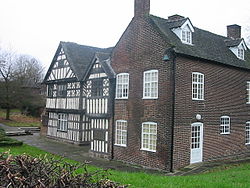Ford Green Hall
| Ford Green Hall | |
| Staffordshire | |
|---|---|
 Ford Green Hall | |
| Location | |
| Grid reference: | SJ88735086 |
| Location: | 53°3’18"N, 2°10’10"W |
| Town: | Smallthorne |
| History | |
| Built 1624 | |
| Farmhouse | |
| Information | |
| Owned by: | Ford Green Hall Ltd |
| Website: | fordgreenhall.wordpress.com |
Ford Green Hall is a Grade II* listed farmhouse[1] and historic house museum at Smallthorne in Stoke-on-Trent, Staffordshire. The oldest parts of the house date from the late 16th century, with one wing being either added or greatly repaired at some point in the early 18th century. In its grounds, there also stands an 18th-century dovecote which shares the listed building status of the main farmhouse.[1]
The house stands on land adjacent to the B5051 minor road in the east of Smallthorne. Originally, it stood in 36 acres of farmland, but this has been gradually encroached upon over the years so that now it is surrounded by comparatively small grounds. Beyond its grounds there is now housing and a nature reserve.[2]
History
The hall is thought to have been built in 1624 for Hugh Ford, a local yeoman farmer, remaining in the Ford family for some 200 years.[3] A brickwork extension was added to the property sometime in the 17th century, most likely replacing or renovating a previous structure.
The Fords had left the area by the 19th century,[4] and after a series of tenants, it was split into three separate dwellings. During this period, the distinctive timber framing was covered in white stucco.[5] The property was purchased by Stoke-on-Trent City Council in 1946 and, following restoration, opened as a museum in 1952.[5]
Today
Ford Green Hall is now operated as a museum and has been furnished as a 17th-century yeoman farmer's house. The museum includes a number of original textiles, ceramics and pieces of furniture, as well as some reproductions.[6] There is an onsite café and the hall also holds a licence for weddings.[7]
Following budget cut backs by Stoke-on-Trent City Council in 2011, the museum was faced with closure. However, in early 2014, a deal was finalised to pass the management over to Ford Green Hall Ltd, a charitable organisation led by local volunteers.[7][8]
The whole of the museum's collection is 'Designated Outstanding' by the Arts Council, recognising it as of world class importance.[9]
Architecture
Exterior
The house a mixture of 16th century timber framing and 18th century brickwork. The right-hand wing, built in the early 16th century, features black and white timber framing decorated with lozenge panels and balustrading. This older wing contains both two and three light mullioned windows and a two-storey gabled porch. On a beam above the inner door of the porch is the inscription ""Ralph Sutton, Carpenter".[1]
The left-hand wing is built of brick and was likely constructed sometime in the early 18th century. This wing was either constructed as replacement for an earlier structure or as a major overhaul of an already existing building. A rainwater head possibly dates this section of the building to 1734.[1]
Interior
The interior doors of the house has moulded gothic, or ogival, archways, decorated with fleur-de-lys detailing. The staircase is believed to either be original to the house or an early 17th century replacement and features decorative balusters and newel posts with acorn-shaped caps.[1]
Dovecote
The hall features an early-18th century brickwork dovecote. The dovecote is attached to the house by a small, brick wall and is circular in shape with a low, conical roof. The listing particulars for the house include the attached dovecote as part of the building's grade II* status.[1]
Outside links
References
- ↑ 1.0 1.1 1.2 1.3 1.4 1.5 National Heritage List 1220313: Ford Green Hall and attached wall and dovecote
- ↑ Martin, Katie (27 January 2009). "Smallthorne's Yeoman Farmers". BBC. http://www.bbc.co.uk/stoke/content/articles/2008/07/30/ford_green_hall_feature.shtml. Retrieved 21 August 2014.
- ↑ "Ford Green Hall". The Art Fund. n.d.. http://www.artfund.org/what-to-see/museums-and-galleries/ford-green-hall. Retrieved 21 August 2014.
- ↑ "Ford Green Hall descendants arrive on pilgrimage". The Sentinel. 20 June 2009. http://www.stokesentinel.co.uk/Hall-s-s-family/story-12535043-detail/story.html. Retrieved 21 August 2014.
- ↑ 5.0 5.1 Malkin, Neville (n.d.). "Buildings of Smallthorne". The Potteries. http://www.thepotteries.org/tour/052.htm. Retrieved 21 August 2014.
- ↑ Caring for our Collections: Sixth Report of Session 2006-2007. II. House of Commons, Culture, Media and Sport Committee. 2007. pp. 394. ISBN 9780215034663.
- ↑ 7.0 7.1 McInnes, Kathie (25 January 2014). "Future of Ford Green Hall is Secure After Volunteers Take It Over". The Sentinel. http://www.stokesentinel.co.uk/Future-Ford-Green-Hall-secure-volunteers/story-20498631-detail/story.html. Retrieved 21 August 2014.
- ↑ "Ford Green Hall". Stoke on Trent City Council. n.d.. http://www.stokemuseums.org.uk/visit/fgh/. Retrieved 21 August 2014.
- ↑ Designated Outstanding Collections. Arts Council England. n.d.. p. 40. http://www.artscouncil.org.uk/media/uploads/pdf/Designated_Collections_List_August_2014.pdf. Retrieved 21 August 2014.